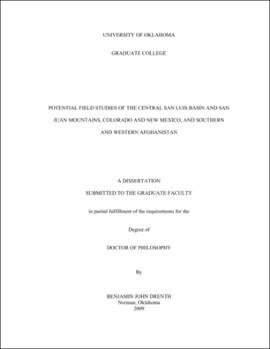| dc.contributor.advisor | Keller, G. Randy | |
| dc.creator | Drenth, Benjamin | |
| dc.date.accessioned | 2019-04-27T21:32:11Z | |
| dc.date.available | 2019-04-27T21:32:11Z | |
| dc.date.issued | 2009 | |
| dc.identifier | 99278319302042 | |
| dc.identifier.uri | https://hdl.handle.net/11244/318938 | |
| dc.description.abstract | This dissertation includes three separate chapters, each demonstrating the interpretive utility of potential field (gravity and magnetic) geophysical datasets at various scales and in various geologic environments. The locations of these studies are the central San Luis Basin of Colorado and New Mexico, the San Juan Mountains of southwestern Colorado, and southern and western Afghanistan. | |
| dc.description.abstract | The San Luis Basin is the northernmost of the major basins that make up the Rio Grande rift, and interpretation of gravity and aeromagnetic data reveals patterns of rifting, rift-sediment thicknesses, distribution of pre-rift volcanic and sedimentary rocks, and distribution of syn-rift volcanic rocks. Syn-rift Santa Fe Group sediments have a maximum thickness of ~2 km in the Sanchez graben near the eastern margin of the basin along the central Sangre de Cristo fault zone. Under the Costilla Plains, thickness of these sediments is estimated to reach ~1.3 km. The Santa Fe Group sediments also reach a thickness of nearly 1 km within the Monte Vista graben near the western basin margin along the San Juan Mountains. A narrow, north-south-trending structural high beneath San Pedro Mesa separates the graben from the structural depression beneath the Costilla Plains. Aeromagnetic anomalies are interpreted to mainly reflect variations of remanent magnetic polarity and burial depth of the 5.3-3.7 Ma Servilleta basalt of the Taos Plateau volcanic field. Magnetic-source depth estimates indicate patterns of subsidence following eruption of the basalt and show that the Sanchez graben has been the site of maximum subsidence. | |
| dc.description.abstract | One of the largest and most pronounced gravity lows in North America lies over the rugged San Juan Mountains in southwestern Colorado. A buried, low-density silicic batholith related to an Oligocene volcanic field coincident with the San Juan Mountains has been the accepted interpretation of the source of the gravity low since the 1970s. However, this interpretation was based on gravity data processed with standard techniques that break down in the SJVF region. We applied an unconventional processing procedure that uses geologically appropriate densities for the uppermost crust and digital topography to mostly remove the effect of the low density units that underlie the topography associated with the SJVF. We also reinterpreted vintage seismic refraction data that indicate the presence of two low-velocity zones under the SJVF. Assuming that the source of the gravity low on the improved gravity anomaly map is the same as the source of the low seismic velocities, integrated modeling defined the dimensions and overall density contrast of the batholith complex. Models show that the thickness of the batholith complex varies significantly laterally, with the greatest thickness (~20 km) under the western SJVF, and lesser thicknesses (< 10 km) under the eastern SJVF. | |
| dc.description.abstract | The Afghan block, a series of Gondwanan terranes that lie between the Eurasian and Indian plates, is coincident with most of southern and western Afghanistan. Recently acquired regional aeromagnetic and aerogravity datasets were used to examine the geophysical expressions of plutons related to magmatic arcs, major tectonic blocks within the broader Afghan block, Himalayan deformation, and the Helmand basin. Numerous plutons are reflected as aeromagnetic highs, allowing these to be mapped in areas where they do not crop out. The Farah and Helmand blocks have distinctive geophysical expressions that separate them from the adjacent Eurasian and Indian plates. West-southwestward crustal extrusion, an effect of the Himalayan orogeny, is indicated to have occurred with greater displacement along the Farah block than along the Helmand block. | |
| dc.format.extent | 164 pages | |
| dc.format.medium | application.pdf | |
| dc.language | en_US | |
| dc.relation.requires | Adobe Acrobat Reader | |
| dc.subject | Geomagnetism--San Luis Valley (Colo. and N.M.) | |
| dc.subject | Gravity--San Luis Valley (Colo. and N.M.) | |
| dc.subject | Geomagnetism--San Juan Mountains (Colo. and N.M.) | |
| dc.subject | Gravity--San Juan Mountains (Colo. and N.M.) | |
| dc.subject | Geomagnetism--Afghanistan | |
| dc.subject | Gravity--Afghanistan | |
| dc.title | POTENTIAL FIELD STUDIES OF THE CENTRAL SAN LUIS BASIN AND SAN JUAN MOUNTAINS, COLORADO AND NEW MEXICO, AND SOUTHERN AND WESTERN AFGHANISTAN | |
| dc.type | text | |
| dc.type | document | |
| dc.thesis.degree | Ph.D. | |
| ou.group | Mewbourne College of Earth and Energy::ConocoPhillips School of Geology and Geophysics | |
